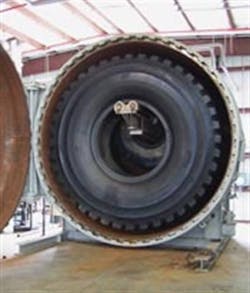Talking with John Yearwood, it doesn’t take long to realize he’s a person who enjoys his work. “It’s neat to be able to retread the largest tires in the world,” he says. “There aren’t that many of us out there!”
His company, Yearwood Tire, a single-location dealership in Victoria, Texas, specializes in giant OTR tire repair and retreading. In fact, that’s all the company does.
“We just took delivery of a 170-inch curing kettle,” says Yearwood, who runs the company with his son, Scott. The kettle -- which was made by Melco Steel Inc. in Asuza, Calif. -- stands 16 feet tall, is 17 feet wide and weighs 65,000 pounds.
It represents a total investment of $500,000, according to Yearwood, who says his company has more than enough volume to justify the expenditure. “We’re retreading about 80 giant OTR tires a month.”
[PAGEBREAK]
Yearwood decided to enter OTR retreading about a year-and-a-half ago “because that’s what I like. I like going in and out of mines, I like buying casings, I like selling tires and I like making applications work.”
The company sells retreads to other tire dealers and above-ground mines, shipping as far north as Canada and as far south as South America. It doesn’t deploy service trucks or personnel to those locations, preferring to leave service to local dealers.
“We work with the tire dealer and the dealer works with the end user. The dealer is there around the clock; he’s there when things are working well and when things are not.”
Yearwood Tire sources casings from all over the world. “I look at everything myself,” he says. However, the severe shortage of large OTR tires has made it extra difficult to find high-quality casings.
Price is another problem. Yearwood says casing prices have been inflated in recent years due to Internet brokers “who drove prices totally out of sight.”
Tire repair is the other major component of Yearwood Tire’s business. The firm employs strict guidelines when it comes to evaluating a tire for repair. Yearwood says he won’t hesitate to scrap a tire that cannot be fixed effectively.
“A failure in OTR is immediate. When it comes down to specs, we know what works. Sometimes a brand new tire might not work on a certain application, much less a repaired tire. I would rather tell my customer I don’t have the product than make the sale and have to go eye-to-eye with him three days later and try to explain why I did this to him. It doesn’t help anyone.”
Because of its culture of fastidiousness, Yearwood Tire boasts an adjustment rate of “next to nothing,” Yearwood says. “In the last three years, I think I could count our adjustments of 57- and 63-inch tires on the fingers of one hand.
The end user bears a certain degree of responsibility in keeping tires running, he adds. “If a mine or quarry is not doing its part, if it’s overloading trucks and scrapers, there’s nothing that will work. The mines that listen (to tire dealer advice) are making it through the shortage.”



